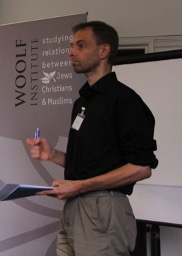 Graham Oppy is Professor of Philosophy at Monash University, and editor of the Australasian Philosophical Review. His recent books include: Is There a God? A Debate (Routledge, 2022, with Kenny Pearce); Atheism: The Basics (Routledge, 2019); Naturalism and Religion (Routledge, 2018); Atheism and Agnosticism (CUP, 2018); Describing Gods (CUP, 2014); Reinventing Philosophy of Religion (Palgrave Macmillan, 2014); and The Best Argument against God (Palgrave Macmillan, 2013). We invited him to discuss comparative philosophy of religion as part of our “Philosophers of Religion on Philosophy of Religion” series.
Graham Oppy is Professor of Philosophy at Monash University, and editor of the Australasian Philosophical Review. His recent books include: Is There a God? A Debate (Routledge, 2022, with Kenny Pearce); Atheism: The Basics (Routledge, 2019); Naturalism and Religion (Routledge, 2018); Atheism and Agnosticism (CUP, 2018); Describing Gods (CUP, 2014); Reinventing Philosophy of Religion (Palgrave Macmillan, 2014); and The Best Argument against God (Palgrave Macmillan, 2013). We invited him to discuss comparative philosophy of religion as part of our “Philosophers of Religion on Philosophy of Religion” series.
In general, philosophy of X takes, as its primary subject matter, philosophical questions thrown up by X. So, for example, the primary subject matter of philosophy of science is philosophical questions thrown up by science. Of course, there is contestation about exactly what science is. But it is not contestable that there are many sciences: physics, chemistry, neurophysiology, etc. Moreover, it is not contestable that there are important and interesting questions in philosophy of science that require consideration of a range of sciences. We cannot say, for example, whether natural sciences and social sciences employ the same methods if we do not pay serious attention to both natural sciences and human sciences.
What goes for philosophy of science goes, too, for philosophy of religion. Philosophy of religion takes, as its primary subject matter, philosophical questions thrown up by religion. Sure, there is contestation about exactly what religion is. But it is not contestable that there are many religions: Islam, Buddhism, Daoism, Dayawism, Hyel, Midewiwin, Aluk, and so on. And it is not contestable that there are important and interesting questions in philosophy of religion that require consideration of a range of religions. We cannot say, for example, what role mastery of existential anxiety plays in religion if we do not pay serious attention to a wide range of religions.
Nothing that I have just said counts against the claim that some philosophers of religion legitimately specialise in philosophical questions that concern a particular religion and that can be pursued without paying attention to other religions (or even other branches of the given religion). The claim, that it is necessary that excellent philosophy of religion is comparative, goes too far. The most that anyone should want to assert here is that there are important and fruitful questions in philosophy of religion that require a comparative approach that considers a range of different religions.
Moreover—though this is a slightly different issue—we might well want to add that, if philosophy of religion is genuinely flourishing, then there will be people in the field working on philosophical questions that are particular to a wide range of different religions.
There are significant challenges to comparative work in philosophy of religion. In particular, there is a practical problem about competence: many people who work in philosophy of religion have an insider perspective on, and know a great deal about, their own religion, but have an outsider perspective on, and know very little about, any religions other than their own. Of course, it is impossible to have an insider perspective on more than a handful of religions. For this reason, it may be that doing serious comparative philosophy of religion really will require some innovation in both questions and methods. (It is worth bearing in mind that there are in the order of 7000 languages and 4000 religions in the world. No single person can be fluent in all of these languages and genuinely knowledgeable about all of these religions.)
Despite the real problems that arise if we are to do excellent comparative philosophy of religion, I do not think that there is a conceptual challenge that arises in the need to work with ‘appropriately vague categories’ that have the flexibility to be applied to a wide range of different religions. At the very worst, what might actually be needed is the development of new, precise vocabulary that is suited to the framing and answering of philosophical questions about religions in general. But, in fact, I suspect that we need very little by way of linguistic innovation in order to be able to carry out comparative philosophy of religion—though we shall certainly need to be open to using terms from a wide range of different languages and religious traditions.
One set of questions that clearly arises for comparative philosophy of religion concerns the choice of particular religions as yardsticks for comparison. Theorists might begin with the assumption that what needs investigating—in a comparative context—is how other religions measure up against their own religion. However, while that starting assumption might be suitable for apologetic purposes, it is not obvious that it is suitable for those who genuinely seek to understand religions other than their own. Where religions are associated with philosophical traditions—including traditions of pursuing philosophy of religion—part of what is up for comparison is the philosophies— epistemologies, metaphysics, philosophies of language, philosophies of science, philosophies of religion, and so forth—that are associated with those religions. (For a now quite old article that takes up some of the issues being gestured at in this paragraph, see: P. Bilimoria (2003) “What is the ‘Subaltern’ of the Comparative Philosophy of Religion?” Philosophy East and West 53: 340. For a more recent article that also takes up some of these issues, see: J. Frazier (2020) “’The View from Above’: A Theory of Comparative Philosophy” Religious Studies 56: 32-48. Perhaps it is worth noting here that discussion about the prospects for comparative philosophy of religion has a significant history. SUNY established a series Toward a Comparative Philosophy of Religion in the 1990s, and Rowman and Littlefield established a series of Studies in Comparative Philosophy and Religion in the 2000s. Much more recently, Springer established a series on Comparative Philosophy of Religion.)
One domain that a developing concentration on comparative philosophy of religion might open up is what could be called comparative philosophy of heterodoxy. There is not much comparative material in contemporary philosophy of religion on zindiqs, nastikas (e.g. charvakas), minim, heretics, apostates, and so on. Nor is there much comparative material in contemporary philosophy of religion on kafirs, chuhras, shiksas, giaours, heathens, ‘outsiders’, and so forth. And there is much that remains to be written, from a comparative perspective in philosophy of religion, on naturalism, materialism, irreligion, non-religious morality, non-religious virtue, non-religious aesthetics, and the like. On the other hand, though, a developing concentration on comparative philosophy of religion might simply extend the period in which philosophy of religion has tended to ignore the various ‘others’ to religion.



